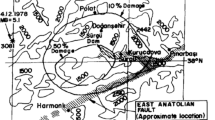Abstract
Concrete faced rock-fill (CFR) dams are now very popular. The structural complexity of these dams and the high risk associated with the social and environmental consequences of failures require very reliable analyses of their performance, especially as regards seismic loading. In this paper, a dynamic analysis procedure for CFR dams is proposed and described, using the Damlapınar CFR dam as a case study. The acceleration time history and maximum horizontal peak ground acceleration values were developed based on maximum credible earthquakes over 50 years from nearby seismic sources. Numerical studies showed that the Damlapınar CFR dam will remain stable under the maximum credible earthquake with a peak ground acceleration of 0.15 g. According to the numerical results, earthquake-induced deformations of the dam are expected to be within the safety margins determined by the Ministry of Public Works and Settlement, Turkey. The results also indicate that a non-linear analysis capable of capturing dominant non-linear mechanisms can be used to assess the stability of CFR dams.
Résumé
Les barrages en enrochement à parement de béton (CFR) sont maintenant communs. La complexité structurale de ces barrages et le risque élevé, en termes de conséquences sociales et environnementales en cas de rupture, demandent des analyses fiables de leurs performances, spécialement en cas de sollicitations sismiques. Dans cet article, une procédure d’analyse dynamique est proposée et décrite, considérant le barrage CFR de Damlapinar comme cas d’étude. L’historique des accélérations sismiques et les valeurs d’accélération horizontale maximale au rocher ont été établis par référence au séisme maximum prévisible résultant de l’analyse des chroniques sismiques de la région durant les 50 dernières années. Des études numériques ont montré que le barrage CFR de Damlapinar restera stable sous l’effet du séisme maximum prévisible avec une accélération de pic de 0,15 g. Suivant les résultats numériques, les déformations du barrage provoquées par le séisme resteront à l’intérieur des marges de sécurité déterminées par le Ministère des Travaux Publics et de l’Aménagement de Turquie. Les résultats indiquent aussi qu’une analyse non linéaire capable de prendre en compte les principaux mécanismes non linéaires peut être utilisée pour évaluer la stabilité des barrages CFR.











Similar content being viewed by others
References
Arrau L, Ibarra I, Noguera G (1985) Performance of Cogoti dam under seismic loading. In: Concrete face rockfill dams design, construction and performance, New York
Bureau G, Volpe RL, Roth WH, Udaka T (1985) Seismic analysis of concrete face rockfill dams. In: Proceedings of symposium on concrete-face rockfill dams—design, construction and performance, New York, pp 479–508
Çetin KÖ, Yunatcı A (2006) Probabilistic siesmic analysis of Karaçay Dam. METU Civil Engineering Department. Agüdos report, Ankara [Turkish]
Clough RW, Chopra AK (1966) Earthquake stress analysis in earth dams. J Eng Mech Div ASCE 92 (EM2):197–211
Duncan JM, Seed RB, Wong KS, Ozawa U (1984) FEADAM: a computer program for finite-element analysis of dams. Department of Civil Engineering, Stanford University, Geotechnical Engineering Research Report No. Su/GT/84-03, November
Fitzpatrick M, Cole B, Kinstler F, Knoop B (1985) Design of concrete face rockfill dams. In: Concrete face rockfill dams—design, construction and performance. ASCE, New York, pp 410–434
Gazetas G, Dakoulas P (1992) Seismic analysis and design of rockfill dams: state-of-the-art. Soil Dyn Earthq Eng 11(1):27–61
Gazetas G, Uddin N (1995) Dynamic response of concrete face rockfill dams to strong seismic excitation. J Geotech Eng ASCE 121(2):185–197
Han G, Kong X, Li J (1988) Dynamic experiments and numerical simulations of model concrete-face rockfill dams. In: Proceedings of the 9th world conference on earthquake engineering, vol 6, Tokyo
Khalid S, Singh B, Nayak GC, Jain OP (1990) Nonlinear analysis of concrete face rockfill dam. J Geotech Eng ASCE 116(5):822–837
Makdisi FI, Seed HB (1978) Simplified procedure for estimating dam and embankment earthquake induced deformations. J Geotech Eng Div ASCE 104(GT7):849–867
Mircevska V, Bickovski V (1998) Two dimensional nonlinear dynamic analysis of rockfill dam. Int symp dam saf 2:859–866
Piao R, Rippe AH, Myers B, Lane KW (2006) Earth dam liquefaction and deformation analysis using numerical modeling. In: Proceeding of the geo congress (GC’06), ASCE, pp 1–6
Prevost JH, Abdel-Ghaffar AM, Lacy SJ (1985) Nonlinear dynamic analysis of an earth dam. ASCE J Geotech Eng 111(7):882–897
Rampello S, Cascone E, Grosso N (2009) Evaluation of seismic response of a homogenous earth dam. Soil Dyn Earthq Eng 29:782–798
Roa FR, Gamboa LA (1996) Seismic analysis of concrete-faced gravel fill dams. In: Proceedings of the international symposium on seismic and environmental aspects of dams design, vol 1, Santiago
Schnabel PB, Lysmer J, Seed HB (1972) SHAKE: a computer program for earthquake response analysis of horizontally layered sites: report no. EERC 72-12. Earthquake Engineering Research Center, University of California, Berkeley
Seed HB, Seed RB, Lai SS, Khamenehpour B (1985) Seismic design of concrete- face rockfill dams. In Proceedings of symposium on concrete-face rockfill dams-design, construction and performance. ASCE, New York, pp 459–78
Seid-Karbasi M, Byrne P (2004) Embankment dams and earthquakes. Hydropower Dams 2:96–102. http://www.civil.ubc.ca/liquefaction/Publications/Hydropower&Dams.pdf
Siyahi B, Aslan H (2008) Earthquake induced deformation of earth dams. Bull Eng Geol Environ 67(3):397–403
Skermer NA (1973) Finite element analysis of El infiernillo dam. Can Geotech J 10(2):129–144
Turkish Earthquake Code (2006) Ministry of public works and resettlement, Ankara
Umut M, Karabıyıkoğlu M, Saraç G, Bulut V, Demirci AR, Erkan M, Kurt Z, Metin S, Ve Özgönül E (1987) Geology of Konya Province and surround (Tuzlukçu-Ilgın-Doğanhisar-Doğanbey) MTA No: 8246, p 39
Zhu Y, Lee K, Collison GH (2005) A 2D seismic stability and deformation analysis. In: Proceedings of the Geo-Frontiers, Jan 24–26. ASCE, Austin, pp 1–15
Acknowledgments
The author would like to thank Dr. Kemal Onder Cetin and Murat Sayan for their valuable comments and help throughout the entire study.
Author information
Authors and Affiliations
Corresponding author
Rights and permissions
About this article
Cite this article
Terzi, N.U. Evaluation of the dynamic response of the Damlapinar CFR dam. Bull Eng Geol Environ 70, 429–438 (2011). https://doi.org/10.1007/s10064-010-0330-y
Received:
Accepted:
Published:
Issue Date:
DOI: https://doi.org/10.1007/s10064-010-0330-y




